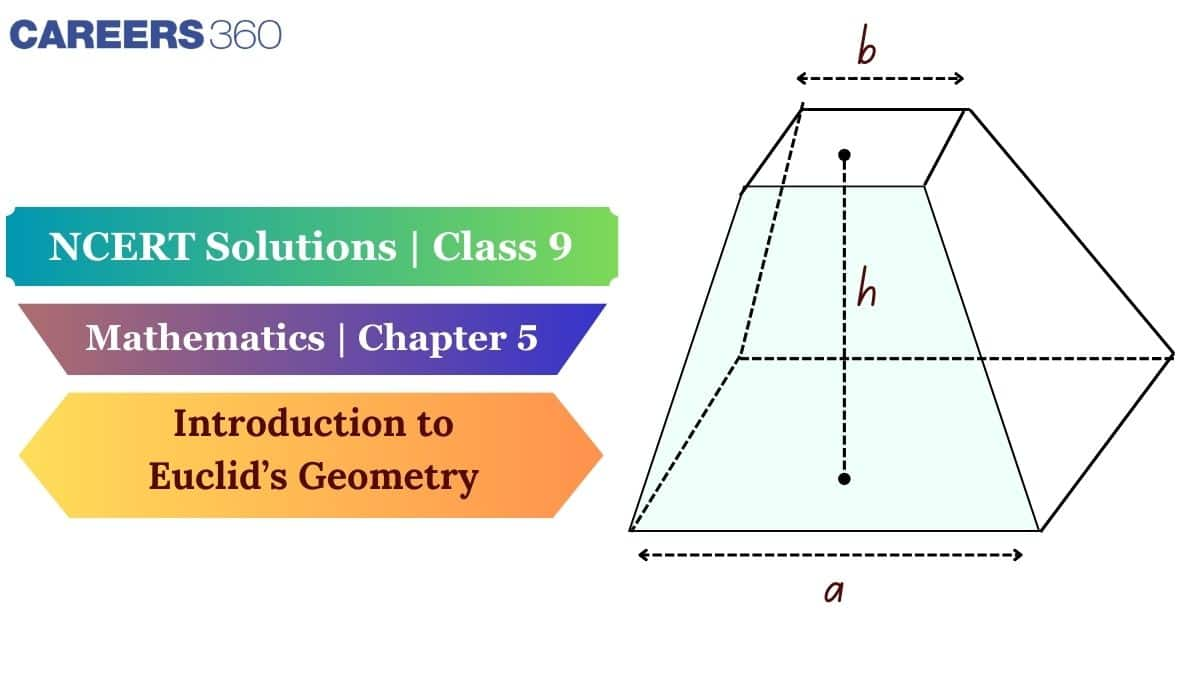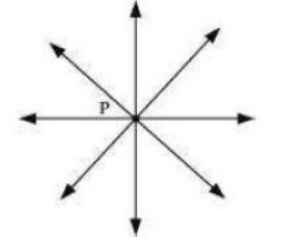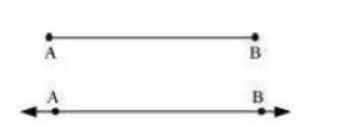NCERT Solutions for Class 9 Maths Chapter 5 Introduction to Euclids Geometry
Have you ever wondered how the house you live in was designed? How are the chairs and tables you use every day made? This is all thanks to Geometry, and the brilliant mathematician who helped to lay its foundation: Euclid, also regarded as the 'Father of Geometry.' Chapter 5 of the NCERT Class 9 Maths, Introduction to Euclid’s Geometry, takes us back to ancient times when Euclid transformed Geometry into a logical discipline using certain rules known as Axioms and Postulates. These simple rules are the foundation of the design and structures we see around us today. And these NCERT Solutions introduce students to the logical foundation of mathematics through well-structured definitions and postulates.
This Story also Contains
- Introduction to Euclid's Geometry Class 9 Question And Answers PDF Free Download
- NCERT Solutions for Class 9 Maths Chapter 5 Introduction to Euclid's Geometry: Exercise Questions
- Introduction to Euclid's Geometry Class 9 NCERT Solutions: Exercise-wise
- Class 9 Maths NCERT Chapter 5: Extra Question
- Euclid's Geometry Class 9 Chapter 5: Topics
- NCERT Introduction to Euclid's Geometry Class 9 Solutions: Important Points
- Approach to Solve Questions of Introduction To Euclid's Geometry Class 9
- Why are Class 9 Maths Chapter 5 Introduction to Euclid’s Geometry Question Answers Important?
- NCERT Solutions For Class 9 Maths Chapter Wise

This article on NCERT solutions for Class 9 Maths provides clear and step-by-step solutions to exercise problems. Our experienced subject matter experts at Careers360 design these NCERT solutions for class 9 to offer a systematic and structured approach, along with step-by-step solutions to important concepts. These solutions help students prepare well for exams and gain knowledge about the natural processes happening around them through a series of solved questions provided in the NCERT textbook exercises. Many toppers rely on NCERT Solutions because they are designed in accordance with the latest syllabus. Explore NCERT Books, Solutions, Syllabus, and Exemplar Problems with Solutions for complete syllabus coverage in this NCERT article.
Introduction to Euclid's Geometry Class 9 Question And Answers PDF Free Download
These NCERT Solutions for Class 9 Maths Chapter 5 Introduction to Euclid's Geometry have been prepared by Careers360 experts to make learning simpler and to help you score better in exams. A downloadable PDF has been provided — click on the link below to access it.
NCERT Solutions for Class 9 Maths Chapter 5 Introduction to Euclid's Geometry: Exercise Questions
Here are the NCERT Class 9 Maths Chapter 5 Introduction to Euclid’s Geometry question answers with clear, detailed solutions.
Introduction to Euclid’s Geometry Class 9 Question Answers
Exercise: 5.1
Page number: 67-68
Total questions: 7
Question 1: Which of the following statements are true and which are false? Give reasons for your answers.
(i) Only one line can pass through a single point.
(ii) There are an infinite number of lines which pass through two distinct points.
(iii) A terminated line can be produced indefinitely on both sides.
(iv) If two circles are equal, then their radii are equal.
(v) In Fig. 5.9, if AB = PQ and PQ = XY, then AB = XY.

Answer:
i) FALSE
Because there is an infinite number of lines that can be passed through a single point. As shown in the diagram below

ii) FALSE
Because only one line can pass through two distinct points. As shown in the diagram below

iii) TRUE
Because a terminated line can be produced indefinitely on both sides. As shown in the diagram below

iv) TRUE
Because if two circles are equal, then their centre and circumferences will coincide and hence, the radii will also be equal.
v) TRUE
By Euclid’s first axiom, things which are equal to the same thing are equal to one another
Answer:
Yes, there are other terms that need to be defined first, which are:
Plane: A plane is a flat surface on which geometric figures are drawn.
Point: A point is a dimensionless dot which is drawn on a plane surface.
Line: A line is a collection of n number of points which can extend in both directions and has only one dimension.
i) Parallel line:-
If the perpendicular distance between two lines is always constant and they never intersect with each other in a plane. Then, two lines are called parallel lines.
Answer:
Yes, there are other terms that need to be defined first, which are:
Plane: A plane is a flat surface on which geometric figures are drawn.
Point: A point is a dimensionless dot which is drawn on a plane surface.
Line: A line is the collection of n number of points which can extend in both the directions and has only one dimension.
ii) perpendicular line:-
If two lines intersect with each other and make a right angle at the point of intersection. Then, two lines are called perpendicular lines.
Answer:
Yes, there are other terms that are needed to be defined first which are:
Plane: A plane is a flat surface on which geometric figures are drawn.
Point: A point is a dimensionless dot which is drawn on a plane surface.
Line: A line is a collection of n number of points which can extend in both directions and has only one dimension.
iii) line segment:
A straight line with two endpoints that cannot be extended further and has a definite length is called a line segment
Answer:
iv) Radius of the circle:
The distance between the centre of the circle and any point on the circumference of the circle is called the radius of a circle.
Q2. (v) Give a definition for each of the following terms. Are there other terms that need to be defined first? What are they, and how might you define them? v) square
Answer:
v) Square:-
A square is a quadrilateral in which all four sides are equal and each internal angle is a right angle.
To define the square, we must know about a quadrilateral.
Question 3: Consider two ‘postulates’ given below:
(i) Given any two distinct points A and B, there exists a third point C which is in between A and B.
(ii) There exist at least three points that are not on the same line.
Do these postulates contain any undefined terms? Are these postulates consistent?
Do they follow from Euclid’s postulates? Explain.
Answer:
There are various undefined terms in the given postulates.:
1) There is no information given about whether the points are in the same plane or not.
2) There is an infinite number of points lying in a plane. But here, the position of the point C has not been specified, whether it lies on the line segment joining AB or not.
Yes, these postulates are consistent when we deal with these two situations:
(i) Point C lies between and on the line segment joining A and B.
(ii) Point C does not lie on the line segment joining A and B.
No, they don’t follow from Euclid’s postulates. They follow the axioms.
Answer:
It is given that
AC = BC
Now,

In the figure given above, AB coincides with AC + BC.
Also, Euclid’s Axiom (4) says that things which coincide with one another are equal to one another. So, it can be deduced that AC + BC = AB
Now,
2AC = AB $(\because AC = BC )$
Therefore,
$AC = \frac{1}{2}AB$
Hence proved.
Answer:

Let's assume that there are two midpoints, C and D
Now,
If C is the midpoint, then AC = BC
And
In the figure given above, AB coincides with AC + BC.
Also, Euclid’s Axiom (4) says that things which coincide with one another are equal to one another. So, it can be deduced that AC + BC = AB
From this, we can say that
2AC = AB -(i)
Similarly,
If D is the midpoint, then AD = BD
And
In the figure given above, AB coincides with AD + BD.
Also, Euclid’s Axiom (4) says that things which coincide with one another are equal to one another. So, it can be deduced that AD + BD = AB
From this, we can say that
2AD = AB -(ii)
Now,
From equations (i) and (ii), we will get
AD = AC
And this is only possible when C and D are the same points
Hence, our assumption is wrong, and there is only one midpoint of the line segment AB.
Question 6: In Fig. 5.10, if AC = BD, then prove that AB = CD.

Answer:
From the figure given in the problem,
We can say that
AC = AB + BC and BD = BC + CD
Now,
It is given that AC = BD
Therefore,
AB + BC = BC + CD
Now, according to Euclid's axiom, when equals are subtracted from equals, the remainders are also equal. Subtracting BC from both sides.
We will get
AB + BC - BC = BC + CD - BC
AB = CD
Hence proved.
Answer:
Axiom 5 states that the whole is greater than the part.
Let's take A = x + y + z, where A, x, y, z are all positive numbers
Now, we can clearly see that A > x , A > y , A > z
Hence, by this, we can say that the whole (A) is greater than the parts. (x, y, z).
Introduction to Euclid's Geometry Class 9 NCERT Solutions: Exercise-wise
NCERT Solutions of Introduction to Euclid's Geometry Class 9 Maths Chapter 5 (Exercise 5.1) are provided in the link below.
Class 9 Maths NCERT Chapter 5: Extra Question
Question: Can two distinct lines intersect in more than one point? Justify your answer.
Answer: No, two distinct lines can only connect at one location.
If two lines overlap at more than one point, they will converge and lose their distinctness.
This is consistent with Euclid's axiom, which states that two separate straight lines cannot share more than one point.
Euclid's Geometry Class 9 Chapter 5: Topics
The topics discussed in the NCERT Solutions for Class 9 Maths Chapter 5 Introduction to Euclid's Geometry are:
- Introduction
- Euclid’s Definitions, Axioms, and Postulates
NCERT Introduction to Euclid's Geometry Class 9 Solutions: Important Points
Axioms:
-
Equality Axiom: If two things are equal to the same thing, they are equal to each other.
-
Addition Axiom: If equals are added to equals, the wholes are equal.
-
Subtraction Axiom: If equals are subtracted from equals, the remainder is equal.
-
Coincidence Axiom: Things which coincide with one another are equal to one another.
-
Whole-Part Axiom: The whole is greater than the part.
Postulates (Euclid's five postulates):
-
Postulate of Straight Lines: A straight line can be drawn from any one point to any other point.
-
Postulate of Line Extension: A terminated line can be produced indefinitely.
-
Postulate of Circle Drawing: A circle can be drawn with any centre and any radius.
-
Postulate of Right Angles: All right angles are equal.
-
Postulate of Parallel Lines: If a straight line falling on two straight lines makes the interior angles on the same side of it taken together less than two right angles, then the two straight lines, if produced indefinitely, meet on that side on which the angles are less than two right angles.
Approach to Solve Questions of Introduction To Euclid's Geometry Class 9
Using these approaches, students can tackle the NCERT Introduction to Euclid's Geometry Class 9 solutions with greater confidence.
1. Understand the historical background: The beginning stage should examine Euclid's geometry, which established modern geometry by using logical structure and systematic reasoning.
2. Learn basic terms and definitions: Point, line, and plane represent essential terms that every student of geometric principles must master because they power the understanding of all geometric concepts.
3. Study Euclid’s postulates and axioms: Devote attention to the five Euclidean postulates as well as common notions, which provide Euclidean geometry with its fundamental base of rules and belief systems.
4. Differentiate between axioms and postulates: All geometry students need to understand that universal truths apply as axioms, while postulates emerge as exclusive rules from geometry.
5. Apply postulates to explain geometric statements: The basic properties of lines and points, along with simple geometric constructions, can be justified and proven using Euclid's postulates.
6. Understand the role of logical structure in geometry: A logical arrangement exists between definitions, axioms, postulates, and theorems that supports the construction of mathematical arguments.
Why are Class 9 Maths Chapter 5 Introduction to Euclid’s Geometry Question Answers Important?
Euclid’s Geometry teaches us the basic rules and logic behind all shapes and figures. It helps us understand how geometry works step by step, starting from simple definitions and rules. These Class 9 Maths Chapter 5 Introduction to Euclid’s Geometry question answers make these ideas easy to understand and practise. Here are some more points on why these question answers are important:
- These solutions help you learn the basic terms, axioms, and postulates of geometry clearly.
- These question answers make it easier to understand how logical reasoning is used to solve geometric problems.
- These Class 9 Maths Chapter 5 Introduction to Euclid’s Geometry question answers prepare us for higher classes where we will study proofs, theorems, and advanced geometry.
NCERT Solutions For Class 9 Maths Chapter Wise
We at Careers360 compiled all the NCERT class 9 Maths solutions in one place for easy student reference. The following links will allow you to access them.
Also, read,
- NCERT Notes Class 9 Maths Chapter 5 Introduction to Euclid's Geometry
- NCERT Exemplar Solutions for Class 9 Maths Chapter 5 Introduction to Euclid's Geometry
NCERT Books and NCERT Syllabus
Given below are some useful links for NCERT books and the NCERT syllabus for class 9:
Frequently Asked Questions (FAQs)
This chapter introduces Euclid’s approach to geometry, explaining the basic terms, definitions, axioms, postulates, and how geometric reasoning is built from them.
There is only 1 exercise, which includes questions on applying axioms, understanding proofs, and solving simple geometric problems.
Free NCERT Introduction to Euclid's Geometry Class 9 solutions PDFs are available on various educational websites and e-learning platforms, including Careers360, in both online and downloadable PDF formats.
Axioms: General truths accepted without proof.
Postulates: Statements assumed to be true to build geometry.
Yes. It is used in architecture, engineering, computer graphics, and any field that requires precise measurements and logical structuring of space.
Euclid was a Greek mathematician, often called the “Father of Geometry”, who wrote the famous book Elements around 300 BCE, laying the foundation for modern geometry.
Here are some key postulates of Euclid:
A straight line can be drawn joining any two points.
A line segment can be extended indefinitely in a straight line.
A circle can be drawn with any centre and radius.
All right angles are equal.
If a line intersects two lines such that the interior angles on the same side are less than 180°, the two lines meet when extended (Parallel Postulate).
The fifth postulate forms the basis of parallel line geometry and is used to prove several theorems about angles, triangles, and other geometric figures.
Courses After 12th
Applications for Admissions are open.
As per latest syllabus. Physics formulas, equations, & laws of class 11 & 12th chapters
JEE Main Important Chemistry formulas
Get nowAs per latest syllabus. Chemistry formulas, equations, & laws of class 11 & 12th chapters
JEE Main high scoring chapters and topics
Get nowAs per latest 2024 syllabus. Study 40% syllabus and score upto 100% marks in JEE
JEE Main Important Mathematics Formulas
Get nowAs per latest syllabus. Maths formulas, equations, & theorems of class 11 & 12th chapters
